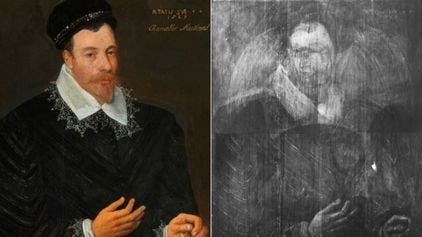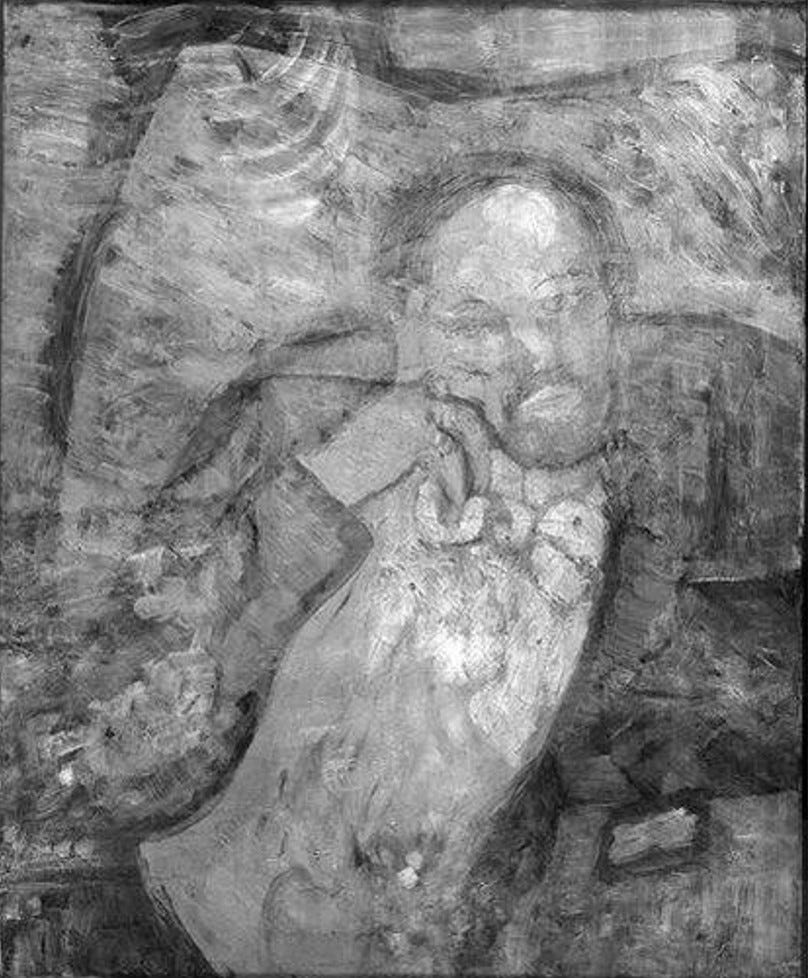The Condemnation of Memory
In 2017, underneath the portrait of a 16th-century man dressed in a black doublet, is believed to be a hidden image of the doomed Queen of Scots.

It all started when Caroline Rae, a research fellow at the Courtauld Institute of Art in London was studying the portrait of Sir John Maitland, 1st Lord Maitland of Thirlestane, one time lord chancellor of Scotland. The portrait normally hung in a gallery in London. Adrian Vanson who was the court painter of James VI of Scotland completed the painting in 1589.
A black and white x-ray revealed what she believed was the face of Mary Queen of Scots (1542-1587), based on a comparison of two miniatures painted of her by Nicholas Hilliard. Her head is tilted sideways, her hand is resting on her waist and she’s wearing a wired cap and square-necked dress.
For some unknown reason, he abandoned Mary’s portrait and used her dress for Sir John’s doublet, and her right hand became his.
Mary, originally known as Mary Stuart was the great-grandniece of King Henry VIII. She was only six days old when her father died, and as his only surviving child she became Mary I of Scotland. She was betrothed by the age of six to Francis the Dauphin of France, and they married when she was 16. She became queen consort two years later when the French king was killed in a jousting accident, and by the age of 18 she returned to Scotland as a widow.
She married her cousin Henry Stewart, and they had James VI. Accusations that she was involved in her husband’s murder forced her to abdicate. Queen Elizabeth her cousin imprisoned her in 1568, and sent her to the executioner the following year, this was two years before the date on the finished portrait. Most probably Vanson was copying her image from other portraits, but he may have disguised her likeness after her execution, since displaying her portrait was a dangerous thing to be doing during those days.
In 1979, a hidden image was found in Johannes Vermeer's (1632-1675) Girl Reading a Letter at an Open Window (c. 1657/59). It was a picture within the picture, showing a naked cupid on the wall of the room in the background. It was determined Vermeer didn't remove the cupid from the piece, and it was done several years after his death, probably around the late 18th century. Who and why the image was hidden is unknown. The cupid in Vermeer's original work suggests the girl is reading a love letter.
The reason could be that the cupid, which was represented by a putto, was once symbolic of profane passions or illicit love. It’s usually depicted in art as a chubby male child, usually naked, sometimes winged. Later it became known as a baby angel often called cherubs. However in traditional Christian theology Cherubim is one of three of the highest spiritual beings in the angelic hierarchy.
This painting in later years was mis-attributed as the work of Pieter de Hooch and it was until 1860 that it was discovered to be a Vermeer painting. During the bombing of Dresden in WWII it was stored with other works in a tunnel in Saxony. The Russian's Red Army found it and took it. After Stalin’s death in 1955 it was returned to Germany, since it was originally purchased by Augustus III of Poland, Elector of Saxony in 1742.
Vermeer also painted Girl with a Pearl Earring (c.1665), which inspired author Tracy Chevalier to write a novel in 1999. In 2003, a film was released with the same title.
This concealment of a subject in a portrait due to political reasons is not isolated. The Latin expression damnatio memorie — the condemnation of memory has been used throughout history.
The Roman senate approved of the destruction of images of previous emperors where their likeness appeared on statues or coins.
During the 16th century, Bernardo de’ Rossi (1458-1527) an Italian bishop commissioned a painting of the Madonna and Child after he survived an attempt on his life. He wanted to include himself in the portrait. Later his family erased him by inserting the image of St. John the Baptist as an infant.
Those were tumultuous times when Mary of Scots, Bishop de’ Rossi and Bianca Capello the Grand Duchess consort of Tuscany by marriage to Francesco I de' Medici, Grand Duke of Tuscany (1548-1587) lived.
In October, 1587, she and her husband Francesco died within a day of each other. Some believed it was poison, other historians think they died from malaria. Since she was not an official member of the Medici family, Cardinal Ferdinand, her brother-in-law, did not allow her to be buried in the family tombs. It’s theorized she was buried in an unmarked mass grave under the church of St. Lorenzo in Poggio a Caiano.
Ferdinando de’ Medici not only relegated her to an anonymous grave, but had many of her portraits destroyed.
In 2006, toxicology tests were carried out at the University of Florence, which found evidence of arsenic poisoning in Francesco’s remains. In 2010, there was also evidence found of the parasite that causes malaria, which was the cause of death Ferdinando attributed to the couple’s demise. Analysis could not be conducted on Bianca's remains since her burial site remains unknown.
The couple struggled with symptoms mostly attributed to arsenic poisoning for 11 days before succumbing. The prevalent belief had always been that the couple were murdered by Francesco’s brother Cardinal Ferdinando. The motive for the crime was that Ferdinando was at risk of being excluded if Francesco and Bianca’s son, Don Antonio was to inherit the title of Grand Duke.
Could Ferdinando have taken advantage that his brother was dying of malaria to dispatch her with a poison that mimicked the symptoms?
The communist regimes of China and the Soviet Union were notorious for erasing photographic record of individuals long before the advent of Photoshop. Nikolai Yezhov, Stalin’s head of secret police was erased in 1940.
Wiping out someone’s image wasn’t only done for political reasons, sometimes it was being practical. Van Gogh was known to repurpose his canvases to save money. Picasso did the same thing. In 2014, a portrait of a man with a bowtie was found under his Blue Room portrait, which he painted in 1901 while living in Paris.
In 2016, Edgar Degas’ favorite model Emma Dobigny, who modeled for him 1869-1870 was found under his Portrait of a Woman.









